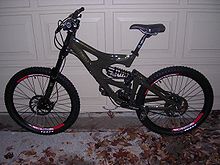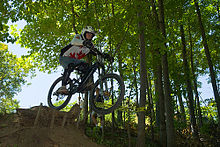- Downhill bike
-
This article is about Downhill bikes themselves. For the associated activity, see Downhill cycling.
A downhill bike (also known as a downhill mountain bike) is a full suspension bicycle designed for downhill cycling on particularly steep, rocky trails. Unlike a typical mountain bike, durability and stability are the most important design features, compared to lighter, more versatile cross-country bikes. Downhill bikes are primarily intended for high speed descent, and downhill riders will usually push, or shuttle via chairlifts or motorized vehicles, to the trailhead.
Downhill bikes are typically made of aluminum or steel, will have 7-10 inches (180-250mm) of rear suspension travel, and be designed around a 7-8 inch (180-203mm) suspension fork. The suspension sag is also much higher than cross-country bikes (25%-50% of total travel vs. 10%-20%) for a more supple ride at higher speeds.
These bikes will also have very slack head tube angles (66 degrees or less), long wheelbases (over 45 inches), and will accommodate the use of up to 3 inch width knobbed tires. Downhill frames are also overbuilt to handle the stress of riding over rocky terrain, drops, and jumps. Bike weights have been typically over 40 lbs (18 kg), but modern downhill bikes have broken the 45 lb weight barrier (such as the Trek Session 10, weighing in at almost 50 lbs). Some newer (2007/8) downhill bikes can be built to weigh under 38 lbs, such as the Santa Cruz V10 or the GT DHi and also the Full Carbon Lahar
Other features include 8 inch (203mm) disc brakes and a chain guide to prevent accidental chain deraillment. Other innovations include the use of OnePointFive head tube standard, which uses a 1.5" wide head tube (see headset), instead of the more conventional 1.125" diameter, for added stiffness and strength. Adjustable head tube angles are also available to adapt the bike to the owner's preferred style of riding.[citation needed]
Downhill bikes are also very similar to freeride bikes due to large strong frames and long travel. Most downhill bikes use triple clamp forks which allow longer travel at the front(usually 203mm/8in) and increased stiffness that a single crown fork cannot offer. Drawbacks though, are increased weight and reduced turning circle.
External links
- IMBA (International Mountain Biking Association)
- "A Brief History of the Mountain Bike" by Jobst Brandt
- Mountain Bike Roots - photos and race results from 1980's events
- MTBrider - Northern Ireland's mountain bike community
Categories:- Cycle types
- Mountain biking
- Cycling stubs
Wikimedia Foundation. 2010.


